15 Remarkable Facts About Jellyfish
Among the remarkable creatures that are lurking in the depths of the sea are
the jellyfish, also known as jellies. The gelatinous marine animals belong to
the division of animals known by the name of Cnidaria (pronounced with a silent
"C"). Found in all parts of the ocean environment, some of the animals even live
in freshwater habitats.
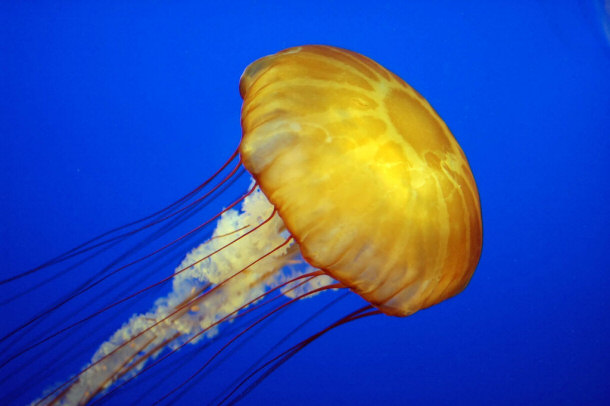
By Dan90266
via Wikimedia Commons
The very colorful jellies have been inhabiting seas and streams for hundreds
of millions of years. They do not have a brain, skeletal system, heart, or
respiratory tract, but possess a highly developed nerve network and tentacles.
Anatomy of Cnidaria Phylum

This sensory network of the bell-shaped jelly easily responds to light, odor,
and other kinds of stimuli. Jellyfish can live in a variety temperature extremes
as well as in a wide scope of saltwater habitats. The marine animals depend on
the tides and currents to move horizontally.
15) Jellyfish Can be Found in Freshwater Ponds and Streams
Typically, jellyfish are associated with saltwater, as the vast majority of
the species (particularly the larger types) are found throughout the world’s
oceans. The marine animals live in the deep sea as well as on the ocean's
surface. You can also find them moving on the currents of freshwater streams.
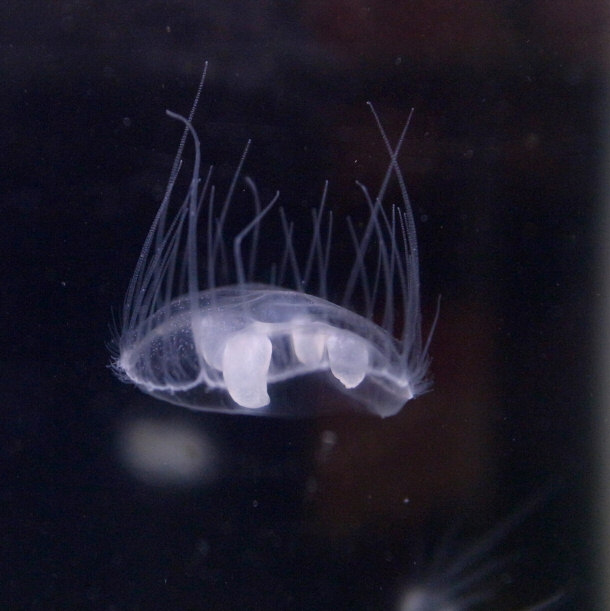
By OpenCage
via Wikimedia Commons
The freshwater variety are scientifically known as as Craspedacusta sowerbii
(C. sowerbii). Beyond the fact that they live in freshwater, the C. sowerbii
differ dramatically from saltwater jellyfish in that they feature a solid outer,
shell-like layer called a velum. Approximately an inch in size, C. sowerbii are
found in freshwater streams and ponds throughout the world.
Known to sting small fish, the freshwater jellyfish also has its own natural
predators in the form of geese, turtles, and crayfish.
Should you find jellyfish in a pond, it may have entered the water when it
was a polyp, attaching itself to a plant or the bait bucket of a fisherman.
Sometimes the animals are transported from flood waters coming from another
locale.
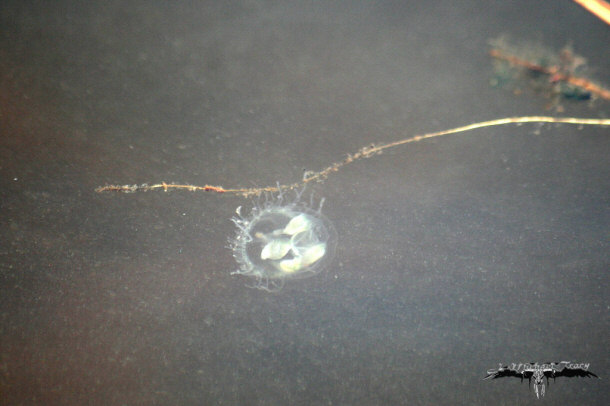
By J. Michael Tracy
via Wikimedia Commons
In recent years, freshwater jellies have been found in areas of the world
where they had never appeared before. Unlike most saltwater jellyfish, the C.
sowerbii are not believed to be a threat to humans.
14) The Term "Jellyfish" - A Misleading Name
Since 1796, the name “jellyfish” has been a common term. However, the
description for the creature has long been considered a misnomer. Jellyfish are
not actually fish – in fact, far from it. Due to the confusing and misleading
nature of the animal's name, scientists are divided when it comes to determining
an appropriate moniker for the creature.
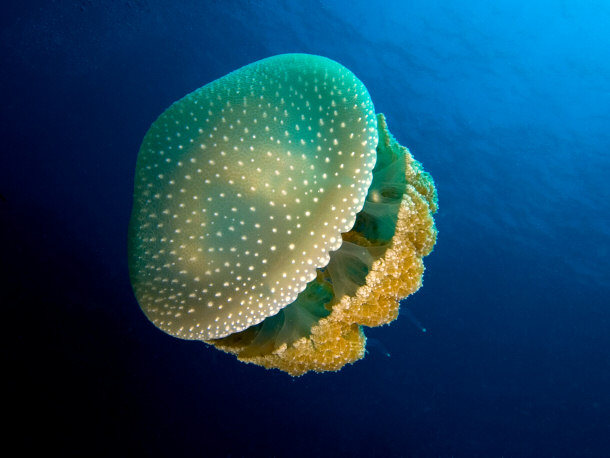
By Papa Lima Whiskey
from Wikimedia Commons
Some aquariums have even gone so far as to encourage the public to call
jellyfish either “sea jellies” or simply “jellies” as the names are considered
to be better describers. Yet, it still is common practice for the animals to
be referred to in scientific papers as “jellyfish” and "jellies."
13) Jellyfish Can Evaporate
Because of their extended and venomous tentacles, jellyfish are ominous
threats if you see them while swimming or boating. However, if they happen to
wash up on shore, they appear much less menacing. While they can still be
dangerous, jellies quickly collapse and almost disappear because of the sun and
heat.
That's because jellyfish are comprised of approximately 95% water, and
therefore cannot hold their form when they are out of their watery surroundings.
It only takes a couple hours for a jellyfish to "evaporate" from view.
Beached Jellyfish
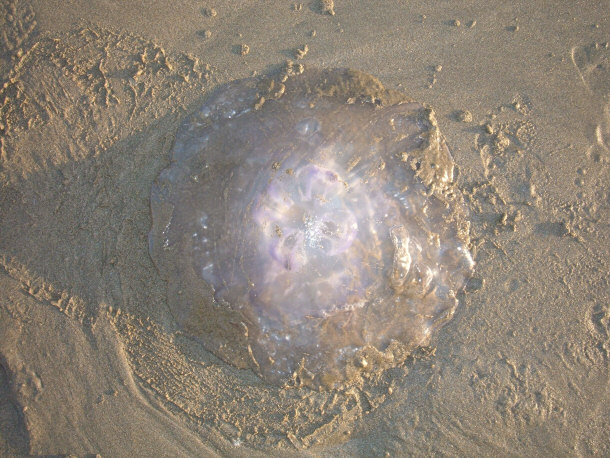
By BrokenSphere
via Wikimedia Commons
Because the gelatinous animals do not possess a skeletal system heart, brain,
or respiratory tract, their most significant features, besides their fluid-like
form, are basic sensory nerves and a digestive tract.
12) The Atolla Jellyfish Can Produce Light
The Atolla Jellyfish, otherwise known as the “Alarm Jellyfish," is one of the
more unusual and impressive of jellyfish species. The "Alarm" reference is
definitely an appropriate descriptive as the Atolla Jellyfish, when attacked,
immediately emits a series of flashing lights. The lights, which are caused by a
chemical reaction, are released by the energy that is produced when the jelly is
attacked.
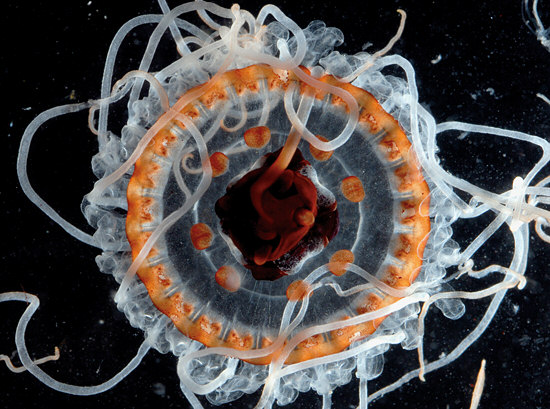
The lights are designed to either startle and confuse an attacker or capture
the attention of the attacker's enemies. So, by preying on the Atolla Jellyfish,
an animal can also become the target of one of its natural predators.
11) The Purple Sailor Jellyfish Uses its Body as a Sail
Of the many jellyfish species that are found in the ocean, the Purple Sailor
Jellyfish is indeed one of the most unique. Known as the "by-the-wind sailor,
the creature can use its body as a sail to drift over the sea. This innate
ability allows the inch-sized jellyfish to cover vast distances in its short
lifetime - a period that lasts no more than 30 to 35 days.
Purple Sailor Jellyfish Washing up in Oregon
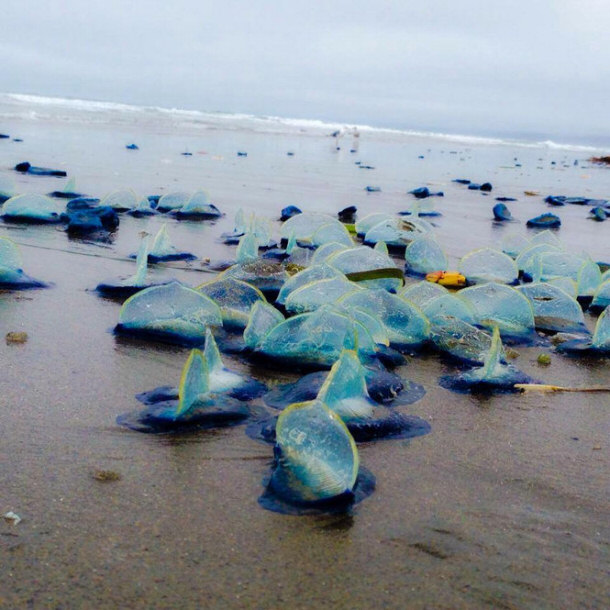
Also known as the Velella Velella, the oval jellyfish displays a translucent
"sail" and bluish tentacles that are used to sting plankton prey. Unlike the
Portuguese Man-O-War, which has a powerful sting, the Purple Sailor Jellyfish is
harmless to humans. The fragile and delicate jellies often are blown ashore in
tropical locales.
10) The Irukandji Jellyfish Can Kill Within Minutes
The Irukandji Jellyfish is one of the smallest species of jellies. Although
it only measures about a half-inch, it is considered extremely dangerous. Highly
poisonous, the diminutive creature is found off the shores of Australia. Because
of its tiny size, the deadly yet small animal can also be hard to spot.
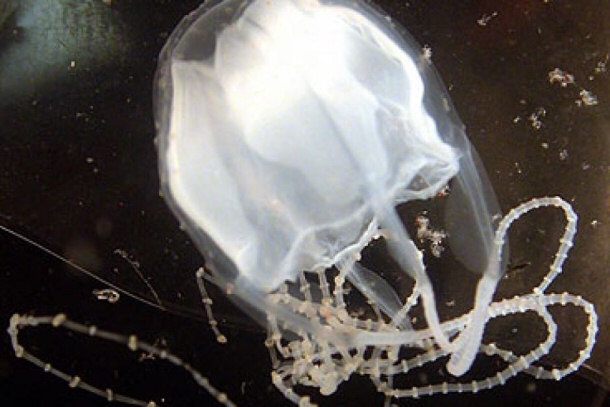
Any human stung by the Irukandji Jellyfish will experience Irukandji Syndrome
- a comprehensive and complex group of symptoms that occur after the initial
sting. After being stung, victims frequently experience vomiting, headache,
tachycardia, excessive sweating, and a significant increase in blood pressure.
Symptoms can last from several hours to days. Victims, in some instances, may
suffer from pulmonary edema, which can result in death.
Also referred to technically as Carukia barnesi, the deadly little
jellyfish's name, "Irukandji," is a reference to the Aboriginal tribe that lives
in the area where stings are frequently reported. The area is situated in a place
called Palm Cover, located off the shore of northern Queensland, Australia.

By Anynobody
via Wikimedia Commons
Related to the jellyfish known as the Meduse Della box, the Irukandji
Jellyfish was first identified by Dr. Jack Barnes in 1964. The researcher
determined a link between the dangerous little jelly and Irukandji Syndrome when
he, his son, and a lifesaver were experimentally stung by the thumb nail sized
jelly.
9) Jellyfish Detect Light or Touch with Their "Net" of Nerves
Although jellyfish do not have brains, they still possess certain abilities
that are seemingly connected with some type of brain activity. For example,
jellyfish can detect light as well as sense touch. They are able to make these
distinctions as they possess a "net" of nerves that enables them to react to
certain stimuli in the sea.
Moon Jellyfish
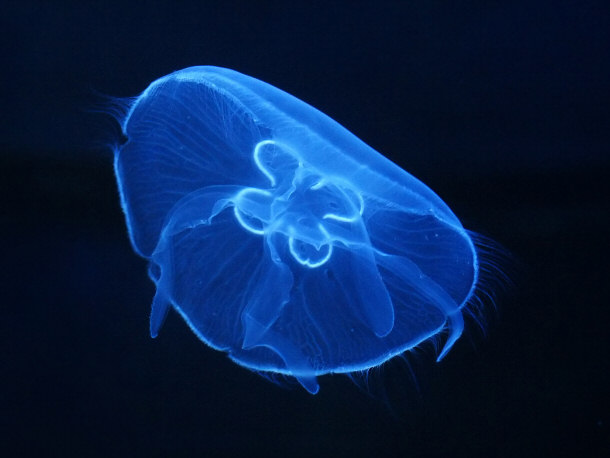
By Hans Hillewaert
via Wikimedia Commons
Otherwise, jellies do not have ears, eyes, or a nose as well as no brain or
heart. You won't even find a head on the watery and gelatinous creature. Neither
do the invertebrates have bones. The gooey creatures do not swim either - they
simply drift or float.
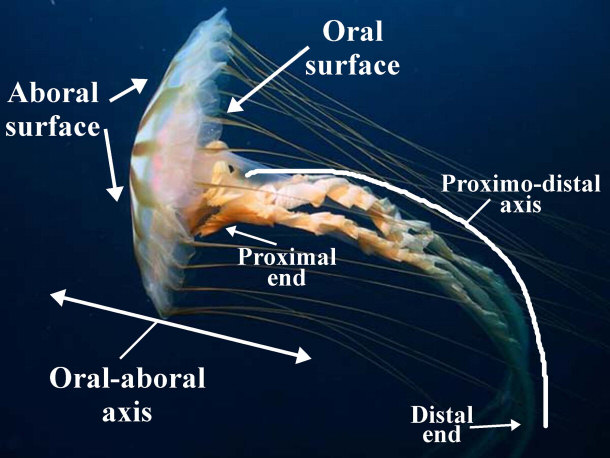
8) Jellyfish Can Still Sting You After They Die
Typically, Jellyfish aren’t just dangerous to people in the water, they can
pose an equal threat onshore as well. Jellies can still sting people after they
have washed up on a beach and have died. That's because the rope-like tentacles
on the creature are still operational after a jelly's demise. Therefore, you can
get stung, even if the long, ropy threads, have broken off the jelly's body.
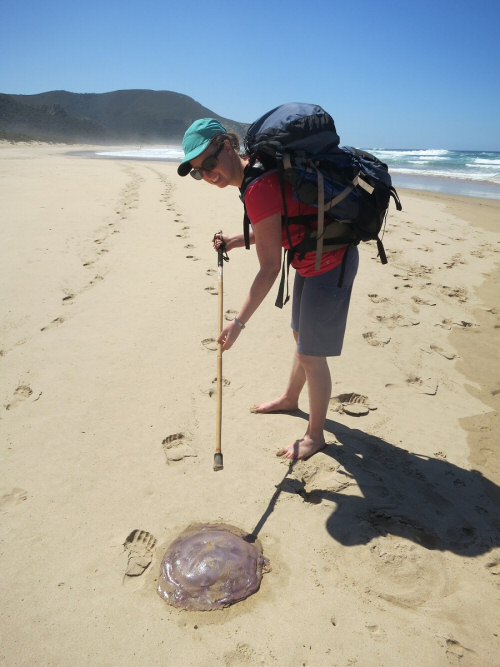
By PretoriaTravel
via Wikimedia Commons
Tentacles feature stinging cells called nematocysts, which are used for food
gathering and self-defense. When the stingers are triggered, they shoot out from
the tentacles, either producing small, irritating stings, or life-threatening
rashes and welts. In poisonous jellies, venomous barbs are released upon any
type of contact, whether the jelly is alive or dead.
7) Jellyfish Blooms - A Problem for Commercial Fishermen
Because of global warming, sea temperatures are increasing - all which has
caused an overpopulation of jellyfish. In fact, some spots in the ocean feature
more jellies than sea. Jellyfish swarms or blooms may extend for vast distances,
thereby disrupting the efforts of the fishing trade. Blooms can tear nets as
well as consume the large amounts of the zooplankton that is eaten by ocean
fish.
Jellyfish Bloom Off Gulf of Mexico
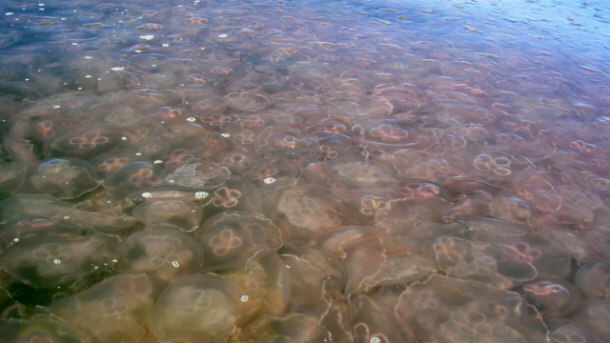
In addition, smaller jellies frequently find their way into aquaculture
confinements and sting or suffocate fish. Since the 90s, jellyfish blooms have
caused the fishing industry problems in such areas as the Sea of Japan, the
Baltic Sea, the Black Sea, and the coastal waters off of France and Spain.
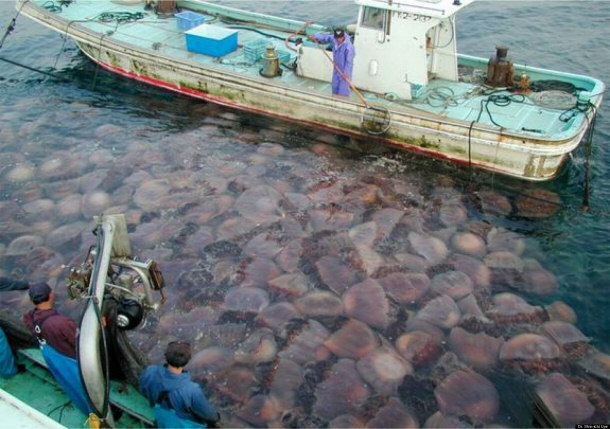
However, all that being said, overfishing is the primary reason for the
overabundance of jellies. Many of the predators of the jelly, such as tuna,
sardines, and herring, no longer thrive as they once did. The smaller fish often
ate the larvae and eggs of jellies too, all which cut down on the population of
jellies at the time.
6) Swimming in Jellyfish Lake is Perfectly Safe
At times, the activity of swimming can become a dangerous activity,
especially if the swimmer gets stung by a jelly. However, jellyfish stings,
which can be deadly, ironically are not a common occurrence in Jellyfish Lake.
Located on the island of Eli Malk in the Republic of Palau, the body of water
is an inviting place to swim. That's because the jellyfish that reside in the
body of water do not have any stingers.
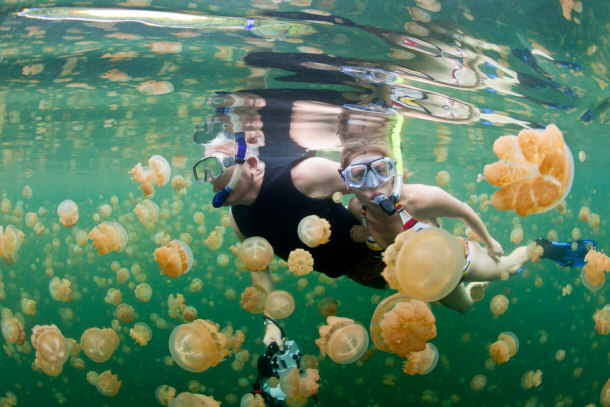
Two types of jellies--known as the Golden Jellyfish and the Moon
Jellyfish--have inhabited the lake for over 12,000 years. The two jellies have
no known natural predators in the area. As a result, the jellyfish evolved
without the need to grow stingers in order to protect themselves.
5) The Box Jellyfish is the Deadliest of Sea Creatures
While most swimmers are afraid of a shark attack, sharks are not the most
harmful creatures in the sea. The Box Jellyfish, also known as the "Sea Wasp,"
is a greater threat than the shark. In fact, more people are harmed and killed
by Box Jellyfish annually. Not only that, the Box Jellyfish is responsible for
more human deaths than any other creature in the sea.
Box Jellyfish Warning Sign
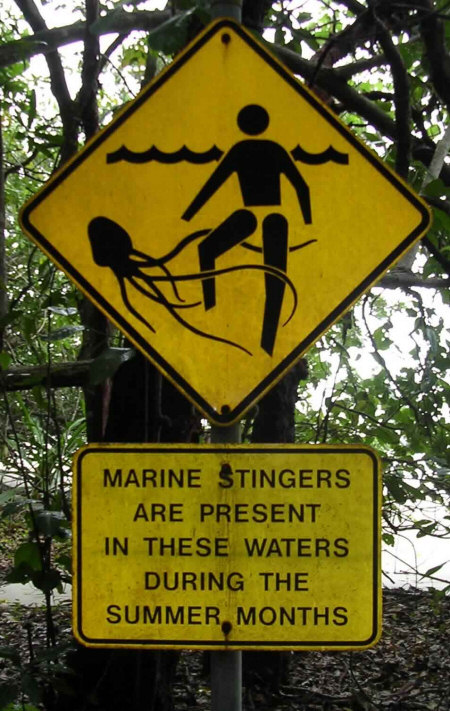
By TydeNet
via Wikimedia Commons
The Box Jellyfish is driven to feed, based on the nerve impulses in its "net"
of nerves. Therefore, the jelly's automatic drive for food causes it to
inadvertently attack and kill all kinds of animals, including humans too.
Sea Wasp Jellyfish or Box Jellyfish
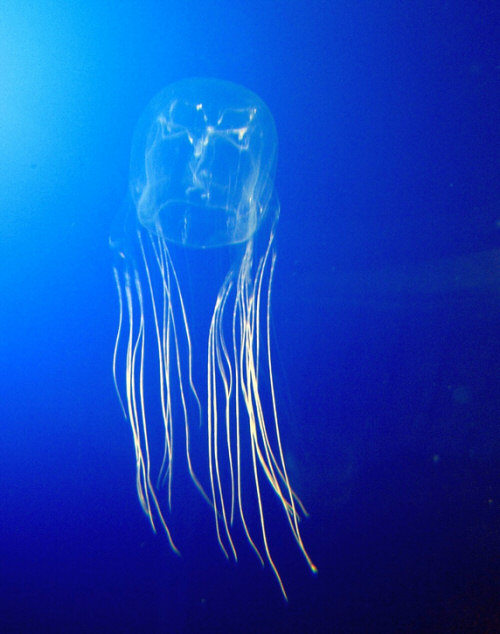
By Avispa marina
via Wikimedia Commons
4) Jellyfish Have Shut Down Power Plants
While jellyfish are often blamed for stings to swimmers and beachcombers,
they also have affected people on an even far grander scale. In some instances,
jellies have caused the shutdown of nuclear power plants.
For example, in 2013, the Oskarshamn nuclear power plant in Sweden was
stalled when a bloom of jellies prevented operations. Literally, tons of the
jellies managed to clog the plant's pipes. The occurrence took place when the
plant was transferring sea water for cooling purposes. It took days to clean the
pipes and for operations to resume.
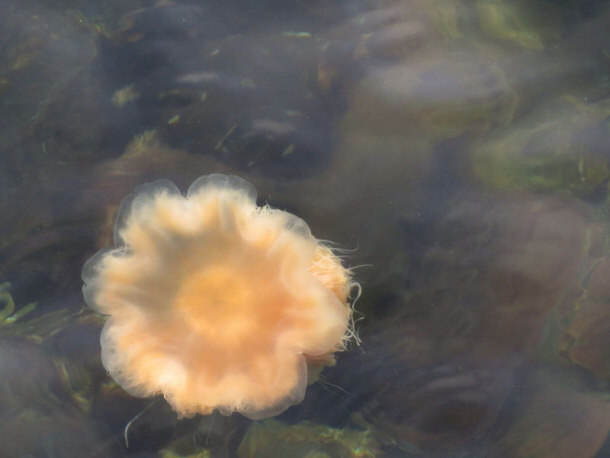
Jellyfish are not a new problem for nuclear power plants. In 2005, the
previously mentioned Oskarshamn plant was shut down when jellies jeopardized
plant operations at the time. Also, in 2012, the Diablo Canyon power plant in
California ceased operations when jellies stopped up the pipeline. The
Philippine island of Luzon also suffered power outages in 1999 when the pipes of
the Saul Power plant were, again, invaded with jellyfish. The local citizenry
blamed the imminent Y2K virus on the shutdown at the time.
Oskarshamn Nuclear Power Plant

By Daniel Kihlgrenvia Wikimedia Commons
Jellies get into pipelines when nuclear facilities use ocean water for
cooling their turbines. According to Lene Moller, a marine biologist who works
for the Swedish Institute for the Marine Environment, such occurrences could
soon become commonplace, due to overfishing and a lack of monitoring.
3) Jellyfish Lived with the Dinosaurs
Compared to other creatures, jellyfish don’t seem all that resilient. In
reality, though, they are one of the most long-living creatures in the history
of the planet. Jellyfish have been around since the time of the dinosaurs.
Mediterranean Jellyfish
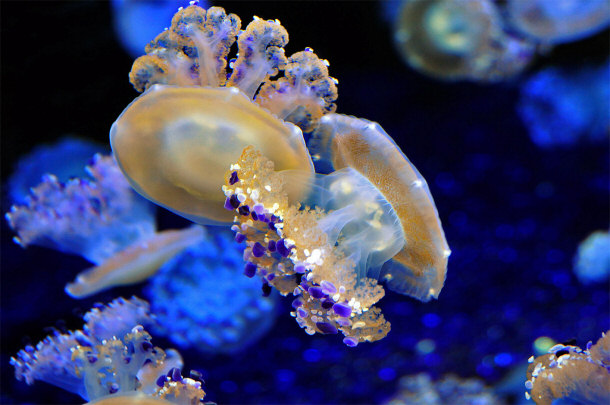
In fact, the oldest jellyfish fossils now date back as far as 700 million
years. Prior to 2007, Jellyfish were believed to be around 200 million years
old. However, a 2007 fossil find showed that jellies were from 500 million to
700 million years old.
What makes this discovery really remarkable is that jellyfish fossils are
incredibly hard to find. Furthermore, these fossils had incredible detailing as
they had been preserved in a fine sediment rather than coarse sand over time.
2) Jellyfish May Solve World Hunger
Because they sting, jellyfish have proven to be, for the most part, a
nuisance. Yet they could offer a solution to world hunger too.
Eaten as a delicacy in Japan, jellyfish are dried before they are prepared
with a combination of sesame oil and soy sauce. Because of the success of the
dish, it has also been served in other countries as well. Dried jellyfish, which
can last for weeks, is sold to the consumer food market for consumption too.
Dried Jellyfish

Because dried jellyfish is a protein-rich and nutritional food, some
scientists have suggested that it could be used to solve food scarcities and
malnutrition in indigent areas in the world. The only nutritional negative about
the food is its higher-than-average content of sodium.
1) The Turritopsis Nutricula Jellyfish Can Live Forever
Among jellyfish species, the Turritopsis Nutricula is considered immortal -
literally. Known appropriately as the "Immortal Jellyfish," the forever jelly
can go from one life stage cycle to the next and back again.
Jellyfish typically go through two primary stages of development. The first
stage, known as the immature polyp stage, is followed by the medusa stage, where
the jelly reaches sexual maturity and dies.
"Immortal" Jellyfish Turritopsis Nutricula
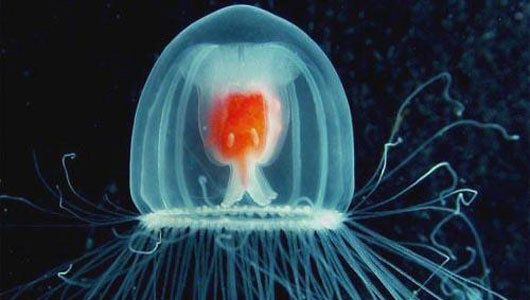
However, in the case of the Turritopsis Nutricula, life does not end after
reproduction. The jelly actually has the ability to revert, once again, to the
initial or polyp state of development. Therefore, the Turritopsis Nutricula can
go back and forth between "youth" and old age. Only the jelly's predators can
end its life.
Summation:
Jellyfish are fascinating, marine-type creatures. Measuring from thumb nail
size all the way to the size of a large truck, the animals possess their own
definitive and unique attributes and characteristics.
Nature
Top Lists:
15 Fascinating Facts about the Amazon Rainforest
15 Remarkable Facts About Bacteria
15 Remarkable Facts About Jellyfish
15 Little Known Facts About Elephants
15 Fascinating Facts about Earthquakes
15 Odd And Interesting Facts about Monkeys
Top 15 Myths about Snakes
Top 15 Myths about Horses
Top 15 Creepy Deep Sea Creatures
15 Unexpected Animals That Can Kill You Quickly
Top 15 Spider Myths
15 Beautiful Animals that are Now Extinct
Top 15 Most Amazing Snakes Around the World
15 Fascinating Facts about Snow
Top 15 of the World's Rarest Flowers
10 Most Emotional Animals
15 of the Most Venomous Creatures to Roam the Earth
15 Unusual Animal Defense Mechanisms
15 Unusual and Less Known Uses of Rocks
15 Unique Forest Creatures Less Known To Man
15 Interesting Facts About Time
15 Unknown Parasites You Never Knew Existed
15 Weird Trees Around The World
15 Wild Animals Deadly to Humans
15 Exotic Insects That Are Harmful & Deadly
15 Ridiculous Uses for Gold
Informational:
Preparing for a Disaster
Proof That We Are What We Are!
What is the Meaning of Life?
The Trend and Challenges Facing the Urban World
Creation Narratives and the Evolution Creationist Debate |